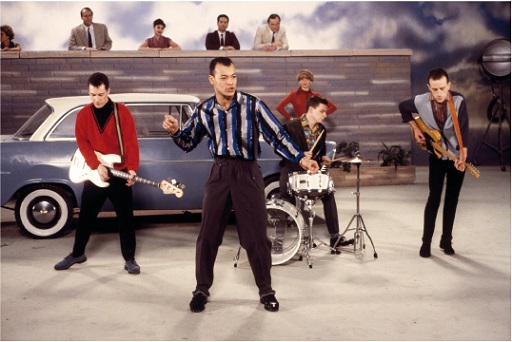7 The bridge
A bridge, as the name suggests, is a passage that connects other components of a song. Although the term is used in a number of ways, the following broad meanings tend to hold. First, bridges are made up of musical material that contrasts with what has gone before – for the most part, verses and choruses. Second, when a bridge has lyrics, these tend to be different from what has been heard earlier. Finally, bridges appear some way into a song, after other important elements have been introduced.
One of the most famous bridges in Western pop is in Mark James’s ‘Suspicious Minds’, a song made famous by Elvis Presley in 1969 and subsequently performed by many other musicians, including Fine Young Cannibals in 1985. It is the latter band’s interpretation that is the basis of Activity 4.
As Table 5 shows, the song begins with a pair of verse–chorus alternations, followed by the bridge, which arrives at 01:45. (The table does not include the music that comes after the bridge.)
| Track time | Section |
|---|---|
| 00:00 | Instrumental introduction |
| 00:11 | Verse 1 (‘We’re caught ...’) |
| 00:41 | Chorus 1 (‘We can’t go on ...’) |
| 00:58 | Verse 2 (‘Should an old friend ...’) |
| 01:28 | Chorus 2 (‘We can’t go on ...’) |
| 01:44 | Bridge (‘Oh, let our love survive ...’) |
Activity 4
Listen several times to the first 02:36 of ‘Suspicious Minds’, following the outline of the structure in Table 5 and trying to determine what happens immediately after the bridge. Then answer the following questions in the box below:
- In what ways (other than the lyrics) is the bridge distinct from the preceding music? Focus on tempo (fastness/slowness), volume (loudness/softness), and the instrumental accompaniment. Do your best to describe what you hear, even if you are uncertain of the technical terms.
- At what track time (00:00) do you think the bridge ends?
- What music is heard after the bridge, and where have you heard it earlier?
Discussion
- The bridge is both slower and quieter than the preceding material, although it increases in intensity in its final moments. The musical accompaniment also changes. Widely spaced, reverberating guitar chords replace the rapid passagework that drove the earlier parts of the song. Similarly, the formerly busy electric bass part becomes more sedate.
- The bridge ends at 02:07.
- The bridge is followed immediately by the first verse, repeated from the opening of the song.
Now that you are familiar with how the various formal components of ‘Suspicious Minds’ sound, it’s appropriate to consider what they accomplish and, in particular, what the bridge contributes to the meaning of the song. The bridge seems to help produce a shift of mood away from the indignation and worry expressed in other parts of the song and towards something more conciliatory. The verses make accusations: ‘Why can’t you see what you’re doing to me?’ and ‘There you go again, asking where I’ve been.’ The chorus describes the impossibility of the situation: ‘We can’t go on together with suspicious minds.’ But the bridge pleads: ‘Don’t let this good thing die.’ The sense of pleading is conveyed in part by musical changes: the bridge is slower, quieter and less frenetic; it sounds momentarily more intimate.

